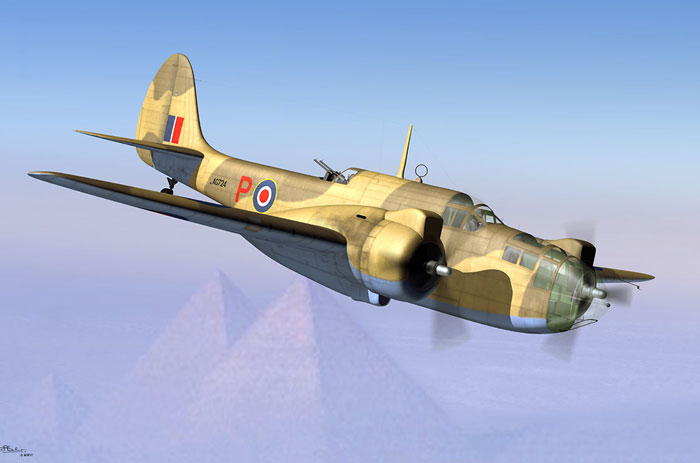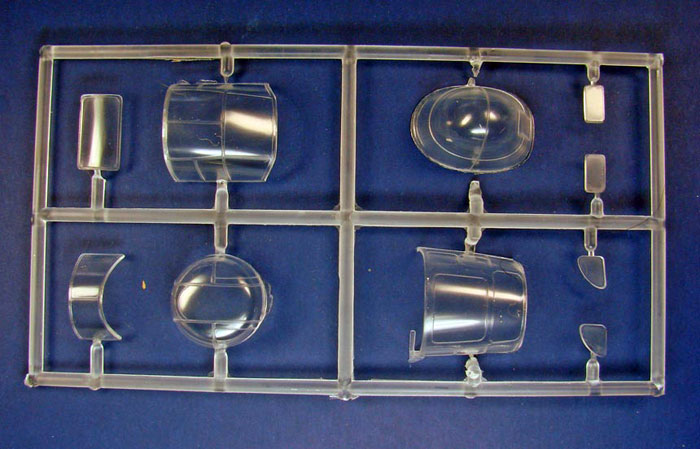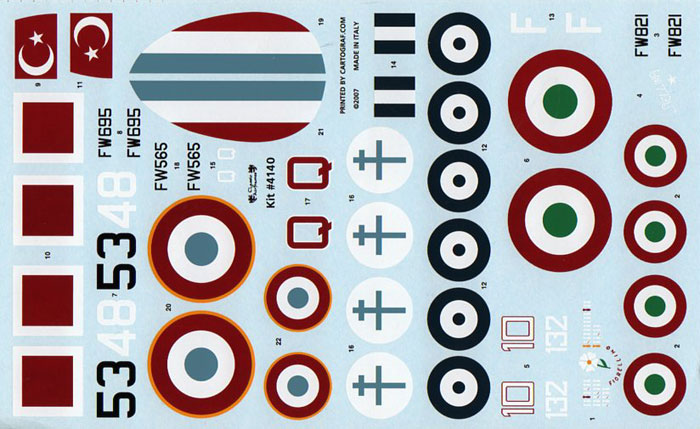|
Martin 187 Baltimore
British & Foreign

Classic Airframes, 1/48
scale
S
u m m a r y |
| Catalogue Number: |
Classic Airframes kit numbers 4139 (British) & 4140 (Foreign) - Martin 187 Baltimore |
| Scale: |
1/48 |
| Contents and Media: |
Both kits - 70 parts in gray styrene, 50 parts in gray colored resin and 10 clear injection molded parts. Instructions, decal sheet and painting guide with markings for 4 aircraft for each boxing. |
| Price: |
MSRP - USD$77.00
Will be available from Squadron Mail Order |
| Review Type: |
FirstLook |
| Advantages: |
Very fine and well executed panel line, finely detailed resin parts, slightly flattened and bulged tires, parts included to make either an aircraft with open dorsal gun or turret, and large desert intake. |
| Disadvantages: |
Cloudy clear parts, off colored decals (for foreign version), gun slits not open on turret. |
| Recommendation: |
Highly Recommended |
Reviewed by
Steven "Modeldad" Eisenman

HyperScale is proudly supported by Squadron
The Martin 187 “Baltimore” was a developed from the Martin 167 “Maryland”. It was designed to British specifications for a tactical attack bomber that was more powerful and had a larger fuselage than the Maryland. The original request was for 400 aircraft, to be spit between the French and British. Upon the fall of France, the British purchased all 400 and all but a couple were sent to the Middle East.
Under Lend-Lease an additional 1175 Baltimores were handed over to the RAF. Late in the war, surplus RAF aircraft were handed over to Free French, Italian Co-Belligerent, Greek and Turkish air force units.
Before I describe what the kit is like, I am forced to be the bearer of some bad news. I have been informed by Classic Airframes that, as manufacturer, they have completely sold out of the production run of both boxings of this model.
All the kits have been sent out to distributors and retailer, so what is now in the stream of commerce is all that will be available to modelers for the foreseeable future. Classic Airframes did not indicate one way or the other whether it will do a second run in the future. So “Limited Run” from Classic Airframes now conveys both meanings of that term.
To keep rumors to a minimum, I have confirmed that none have been held back for sale on Ebay.
As for the kit itself, limited run, in terms of the manufacturing process, certainly has come a long way. Upon opening the box, one will notice the finely and crisply engraved panel lines. The sprue gates have become significantly smaller and now approached the level that one finds on Hasegawa kits.
Classic Airframes has also provided the necessary parts to do virtually all the Marks of the Baltimore. It has done this by providing an injection molded insert for the Mk. I with the open dorsal gun position. It is simply a matter of cutting the fuselage on the designated panel lines and attaching the insert.
If you want to do this as “accurately” as possible, you will need to eliminate the bottom curve of the turret panel line and add addition hand/foot holds. However, the instructions do not indicate these minor additional changes.
The kit also comes with the larger tropical intakes, which are cast in resin. The resin parts in general are beautifully cast, as can be seen in the open back “office chair” for the radio compartment. Care must be taken with the resin, as the machine gun barrels for the turret guns are molded separate from the breaches. The Vickers gun, with its ammunition drum, for the open dorsal gun position is cast in resin as a single piece.
I was quite concerned when I took out the clear parts from their plastic bag. Mine were hazy and looked scuffed. Not an uncommon issue with limited run kits.

I dunked them in a cup of Future and they dried clear and bright without any evidence of their previous condition.
Of course, the question that is always asked is “is it accurate?” In the case of the Baltimore, that is somewhat difficult to answer, as the amount of published information, in English, on this aircraft is quite limited.
Given the generally published dimensions of a wing span 61 feet 4 inches and a length of 48 feet 6 inches, the model appears to be perhaps a foot too long in span but just about spot on in length.
If you have the AJ Press monograph, I’m sure you will pull out the 1/48 scale plans and place the parts on the drawings. There one will see some issues.
But given the fact that I do not know if those drawings are accurate, I’m not sure if the issues are real. For example, the kit’s cockpit opening seems to be about a foot longer than the drawing. Also, the top rear of the nacelles appears to be broader in the drawings, than those in the kit.
A note on molded-in detail. On the bottom of the fuselage, on each side of the ventral window, are two molded depressions. These represent the openings for rearward firing machine guns. However, on many aircraft, especially the later Marks, these were faired over. So check references.
Also there is the issue of the wing machine guns. The Marks I, II, III and IIIA, for the most part, did not have them (The Mk. I and II had the open dorsal gun position, the Mk. III had a Boulton Paul turret, and cannot be made from this kit, the Mk. IIIA had the Martin turret, as provided in the kit). The Marks IV and V (Both of which had the Martin turret.) had two machine guns in each wing between the landing light and nacelle.
On the underside of each wing is a panel and ejection ports for the guns. But, the leading edge has no provision for the opening. For a Mk. 1 to IIIA you will need to eliminate the ejection ports and panel lines. For the Mk. IV and V, you will need to put openings in the leading edge.
Overall however, the kit appears to capture the shape of the Baltimore quite well.
In looking at potential construction issues, one quickly notices that that the main wing attachment is minimal at best. Only the thin edge of the top and bottom of the wing butt join to the fuselage. Making a spar would be most beneficial to aid in the assembly and in strengthening the attachment.
The construction of the wheel wells (parts 27) is most interesting indeed – plastic that needs to be folded. I first came across this in the Mirage PZL 23 Karas. I kept looking for a “3-dimensional” fully formed dustbin gun position in the parts for that kit. What I found was a flat piece of plastic that was “scored” for folding. This is done for the wells in the Baltimore. So don’t think they are not in the kit. They are there, just flat pieces. While the side walls have some detail, the top if the well is the underside of the nacelle and devoid of detail.
With regard to interior detail in general, it is quite minimal, and given the extent of the clear parts, some embellishment is warranted.
One issue that I see to be a test of skill in construction is the turret. It is molded without opening slots for the guns. One must carefully drill and then file open the two slots. In the alternative one could use an ultra-fine razor saw, such as the wood handled JLC, available in the US from UMM-USA. I can see modelers asking for replacement for this part. In my best Elmer Fudd voice, all I can say is “be very, very careful.
The actual assembly appears to be quite straight forward, and other than the issues noted above, I do not see any impediments at this point.
The decals are printed by Cartograph of Italy. I do not have the British decals, so I cannot comment on the specifics. The decals for the foreign boxing do present three problems. First, the red appears to be a too dark and deep in color for the French, Turkish and Italian Markings. The blue for the Greek markings is also too dark, nearly a navy color. Third, the proportions of the Greek roundel appear to be off in that the central blue spot appears too small. The decals are cleanly printed and in register.

Kit 4139 – British
-
Mk. I, AG 724, “P” of 223 Squadron, July 1942. The aircraft is portrayed as being in Dark Earth, Middle Stone and Light Mediterranean Blue. This aircraft may originally have been in Dark Green Dark Earth and Sky Grey and repainted in the Mediterranean.
-
Mk. V, FW418, “A” of 13 Squadron. Dark Earth, Middle Stone and Light Mediterranean Blue.
-
Mk. V, FW287, “A” 55 Squadron, Cecina, Italy, 1944. Experimental night camouflage scheme of overall semi-gloss black.
-
Mk. IV, FA654, “X”. This aircraft is in the Coastal Command scheme of White and Extra Dark Sea Grey. On the nose is the name “ΕΛΛΗ” (“Hellay” / Greece) in Greek letters. I believe this aircraft served with 13 “Hellenic” Squadron of the RAF in the Mediterranean.
Kit 4140 – Foreign
-
Mk. V, FW821, “Grappa 10” of 132° Gruppo, Italian Co-Belligerent Air Force, 1944. Dark Earth, Dark Green, Light Mediterranean Blue (or possibly Azure). The aircraft has the name “Fiorelino” (little flower) on the nose, with a white flower with a yellow center, which was the personal emblem of the pilot, Ten. Roberto Crespi. It also had a star on the fin with the word Stellina, which was the markings of the prior pilot, S.Ten. Rolandi.
-
Mk. V, FW695, “5348”, Turkish Air Force. Middle Stone, Dark Earth and Light Mediterranean Blue.
-
Mk. V, 13 Squadron Royal Hellenic Air Force, 1944. Dark Green (over painting of Middle Stone), Dark Earth and Light Mediterranean Blue. RHAF roundel and fin flash.
-
Mk. V, FW565, “Q” of GB 1/17 “Picardie”, Free French Air Force, Rayak, Syria, circa 1945. Dark Green, Dark Earth and Light Mediterranean Blue. As noted in the marking guide, the use of the Corss of Lorraine on the underside of the wing is open for debate. Decals are available in the kit for these under-wing markings, should you decide to use them.
While there are clearly some concerns, the issuance of a 1/48 Baltimore fills an important gap in the less than celebrated aircraft of the Second World War. It is not a small model and is about the size of an A-20, but a whole lot chunkier. It will make an impressive addition to ones collection.
I’m sure some will take issue, but in terms of my modeling interests, I consider this Classic Airframes Baltimore to be highly recommended.
References:
Martin 187 Baltimore; Krzysztof Janowicz & Adam Jarski; AJ-Press; 2005.
Martin Baltimore – Ali Straniere in Italia; Marco Gueli; La Bacarella Aeronautica –Torino; 2004.
Air Arsenal North America; Phil Butler & Dan Hagedorn; Midland; 2004.
British Airplanes of World War II; ed. Daniel J. March; Aerospace Publishing Limited; 1998.
Thanks to
Classic Airframes for
the review sample.
Classic Airframes
kits are available worldwide through hobby retailers and from
Squadron.com
Review and Images Copyright © 2008 by Steven "Modeldad"
Eisenman
Page Created 12 March, 2008
Last updated 12 March, 2008
Back to HyperScale Main Page
Back to Reviews Page |
